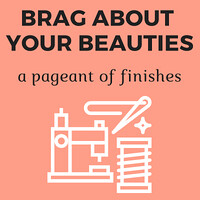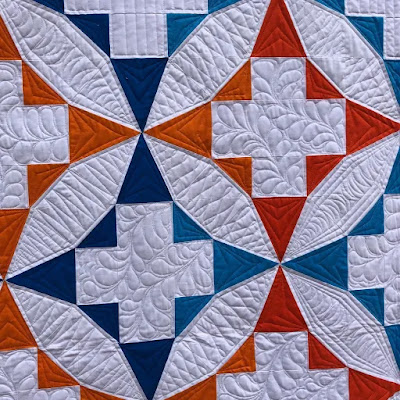Five years ago, I posted a tutorial on Sew Mama Sew for my Good Day Sunshine Quilt. A lot has changed in those five years—most notably, Sew Mama Sew shut down, taking with it tons of information and inspiration—but other things haven’t, and this project, born from my abundance of scraps and love for modern chevrons, is as versatile and relevant today as it was back then. I post it here because I think it’s too good not to. : )
Organizing Your Scraps
Before we delve into the super-simple tutorial, however, let’s talk scraps. I’ve mentioned before that I like scrappy projects with a clear palette and structure. I know that’s not true for everyone, but I thought I’d walk you through how I approach organizing my scraps and pulling a project from them ...
The only hard-and-fast rule I have to scrap organization is that I don’t keep anything smaller than a 2-inch square. (That may pain some of you. I used to keep only pieces that were 2.5-inch squares or larger, so I’ve loosen up over time!) Some scraps—usually the ones that are on the small side or are weird shapes—get cut into 2-inch squares or 2.5-inch squares and get stored in plastic bins based on size. All my larger pieces get sorted by color and neatly arranged in a single dresser drawer. (For real.
See a pic here.) I tend to keep Art Gallery scraps, Alison Glass scraps, and other bits I deem extra special in their own Ziploc bag.
Determining Your Palette
Those beautiful fabrics on the left of the picture below, from Josephine Kimberling’s Turkish Delight line and the foundation for one of my Sew Together Bags, established the palette for Good Day Sunshine’s pixelated chevrons in true blue, grassy green, gold, gray and navy. Since I was using white as a background color, I tried to use it sparingly in the chevrons to achieve good contrast between them and the background.
When I had culled through my scraps in search of those five colors and had cut all the 2.5-inch squares I could, I had 284 squares—less than half of what I needed! So I went back to my scraps and found the gray floral (bottom left in the picture below). It featured some of the colors I was already using and incorporated orange, which expanded my chevron palette to six colors. I took a second pass through my scraps with my revised plan and found almost all of the 580 squares this quilt calls for.
Cutting From Yardage
Like I said earlier, developing a cohesive palette is key for me when sewing a scrappy quilt, but even my overflowing scrap bin has its limits. I decided to trim a few 2.5-inch strips from yardage so I could better balance the colors for this quilt. A width-of-fabric strip yields 16 squares, adding good variety to the quilt while still leaving a chunk of yardage in the stash for future projects.
Sewing Good Day Sunshine
Materials
580 patterned 2½" squares for the chevrons (just over 2½ yards of fabric)
2 yards of solid fabric or 25 solid jelly roll strips for the background
½ yard of fabric for the binding*
3½ yards of fabric for the backing*
64" x 76" piece of batting (this provides approximately 3" of overhang on each side)
Finished size: approximately 58" x 70". All seams are ¼".
* If you like wiggle room to account for a miscut or two, buy a bit more binding and backing fabric.
Cutting
Note: Cutting instructions presume 42" of usable fabric after selvages are removed.
If you’re using yardage for the background, cut (25) 2½" width-of-fabric (WOF) strips. Then subcut those 25 strips or your 25 solid jelly roll strips into rectangles:
- Cut (19) 2½" x WOF solid strips into (95) 8" x 2½" rectangles.
- Cut (2) 2½" x WOF solid strips into (14) 6" x 2½" rectangles.
- Cut (2) 2½" x WOF solid strips into (14) 4" x 2½" rectangles.
- Cut (1) 2½" x WOF solid strip into (14) 2" x 2½" rectangles.
Sewing the Base Strips
Sew the 580 patterned squares into strips of five, for a total of 116 scrappy 10½" x 2½" strips. There’s no need to overthink the fabrics you use in a particular strip, but try to distribute colors evenly.
If you like to press your seams open, iron now. Otherwise, you can wait until later and press to one side so that your seams nest nicely.
Sew 87 of the 95 solid 8" x 2½" rectangles with the 116 scrappy 10½" x 2½" strips to create 29 strips that look like the picture below.
Laying Out and Completing the Strips
Determine the order in which you want to lay out these strips, trying to distribute the colors evenly throughout the quilt top. Sew the remaining rectangles as illustrated below.
A: 8" x 2½" solid rectangle on the top; none on the bottom
B: 6" x 2½" solid rectangle on the top; 2" x 2½" solid rectangle on the bottom
C: 4" x 2½" solid rectangle on the top; 4" x 2½" solid rectangle on the bottom
D: 2" x 2½" solid rectangle on the top; 6" x 2½" solid rectangle on the bottom
E: none on the top; 8" x 2½" solid rectangle on the bottom
If you are sewing your seams to one side, iron now, alternating the direction between columns.
Sew the completed columns together. It’s important to note, however, that the bottom of each A column and the top of each E column are ½" longer than the other columns. Wait until you’ve matched seams and sewn the columns together before trimming off that excess.
Finishing the Quilt
To make the backing, cut your 3½ yards of backing fabric into two rectangles: 63" x WOF. Sew them along the long side. Quilt and bind your project.
Follow Me On ...
* * *
The pageant rules are simple:
- Post your finish in the linky tool. (No links to your own giveaway or linky, please!)
- Point your readers back here with a text link or use the button above.
- Visit and comment on other participants’ finishes.



















